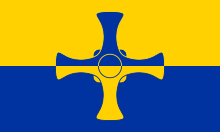County Durham
County Durham is a county in north-east England. There are four different types of county:
- the historic County of Durham
- the administrative county of Durham
- the ceremonial county of Durham
- the non-metropolitan county of Durham

County Durham | |
|---|---|
| Sovereign state | United Kingdom |
| Constituent country | England |
| Region | North East England |
| Origin | Historic |
| Time zone | UTC±00:00 (Greenwich Mean Time) |
| • Summer (DST) | UTC+01:00 (British Summer Time) |
| Ceremonial county | |
| Area | [convert: needs a number] |
| • Ranked | of 48 |
| • Ranked | of 48 |
| Density | [convert: needs a number] |
| Ethnicity | 98.6% White |
Its county town is Durham.
The form of the county name is unique in England. Many counties are named after their principal town, and the expected form here would be Durhamshire. But County Durham did not become a shire/county until after the language of government was changed from Anglo-Saxon to Norman French in 1066. Previous to that it was a semi-independent Bishopric.[1] Durham County Council promotes the non-metropolitan county for tourism purposes as "The Land of the Prince Bishops" in reference to the former palatine jurisdiction of the bishops.[2]
Definitions change
Historic County change
The historic county covered from the Pennines in the west, the River Tees in the south, the North Sea in the east and the Rivers Tyne and Derwent in the north.
The county several had a number of exclaves: Bedlingtonshire, Islandshire and Norhamshire within Northumberland, and Craikshire within the North Riding of Yorkshire. The historic boundaries were used for parliamentary purposes until 1832, and for law courts and local government until the Counties (Detached Parts) Act 1844, which merged most remaining exclaves with their surrounding county.
Administrative county change
In 1889, under the Local Government Act 1888 England and Wales was divided into administrative counties and county boroughs. Administrative counties, governed by an elected county council, were based on the historic boundaries, less larger towns which became self-governing as county boroughs.
In 1889 the administrative county of Durham consisted of the historic county less the county boroughs of Gateshead, South Shields and Sunderland. The boundary with the North Riding of Yorkshire was adjusted: the part of the town of Barnard Castle that was in Yorkshire was added to County Durham, but the part of the Borough of Stockton-on-Tees in Durham was given to the North Riding. For all non-administrative purposes, such as lieutenancy, the County of Durham comprised the administrative county and associated county boroughs.
Over its existence, the administrative county lost territory, both to the existing county boroughs, and also due to the creation of county boroughs at West Hartlepool in 1902 and Darlington in 1915. In 1967 the borough of Hartlepool was removed from the administrative county when it merged with West Hartlepool to form a new county borough of Hartlepool, and in 1968 Billingham was included within the boundaries of the county borough of Teesside, associated with the North Riding.
The administrative county was abolished in 1974.
Non-metropolitan county change
In 1974 Durham was divided between three counties. The boroughs of Hartlepool and Stockton-on-Tees became a part of the new non-metropolitan county of Cleveland. The metropolitan county of Tyne and Wear became responsible for Gateshead, Sunderland and South Tyneside.[3] The new non-metropolitan county of Durham also covered the former area of Startforth Rural District, a part of the historic North Riding of Yorkshire, and south of the historical boundary of the River Tees.
The Department for Communities and Local Government has said that the seven district councils and the County Council will be abolished and a new unitary authority for the whole of the existing County Council area will be created. The change will be on 1 April 2009 at the latest.[4][5] The successful Durham County Council bid referred to the new authority as County Durham Council.
Ceremonial county change
In 1997 the non-metropolitan county (including unitary Darlington), together with that part of the former county of Cleveland north of the River Tees became a ceremonial county. Lord-lieutenants and high sheriffs are appointed to the ceremonial county of Durham. they have no job in local government.
Settlements change
This is a list of the main towns in County Durham. The area covered is the entire ceremonial county, hence the inclusion of towns which are no longer administered by Durham County Council.
Places of interest change
- Auckland Castle, Bishop Auckland
- Barnard Castle
- Beamish Museum, in Stanley
- Bowes Museum, in Barnard Castle
- Causey Arch, near Stanley
- Durham Cathedral and Castle, a World Heritage Site
- Escomb Saxon Church, near Bishop Auckland
- Finchale Priory, near Durham city
- Hamsterley Forest
- Hardwick Hall Country Park near Sedgefield
- High Force and Low Force waterfalls, on the River Tees
- Killhope Wheel, part of the North of England Lead Mining Museum in Weardale
- Locomotion railway museum, in Shildon
- No Place, near Stanley
- Pity Me
- Raby Castle, near Staindrop
- Tanfield Railway, in Tanfield
- Parkhill FC
References change
- ↑ [1].
- ↑ "Welcome to County Durham (Durham County Council)". Archived from the original on 2006-12-16. Retrieved 2007-11-06.
- ↑ Local Government Act, 1972
- ↑ Durham County Council Archived 2007-05-14 at the Wayback Machine - Local Government Review in County Durham
- ↑ Communities and Local Government Archived 2007-08-23 at the Wayback Machine - Proposals for future unitary structures: Stakeholder consultation
Other websites change
- Durham County Council
- Spennymoor Local History Archived 2007-10-16 at the Wayback Machine
- One North East guides & brochures Archived 2007-03-03 at the Wayback Machine
- Guided Walks Programme from Durham County Council Archived 2008-02-03 at the Wayback Machine